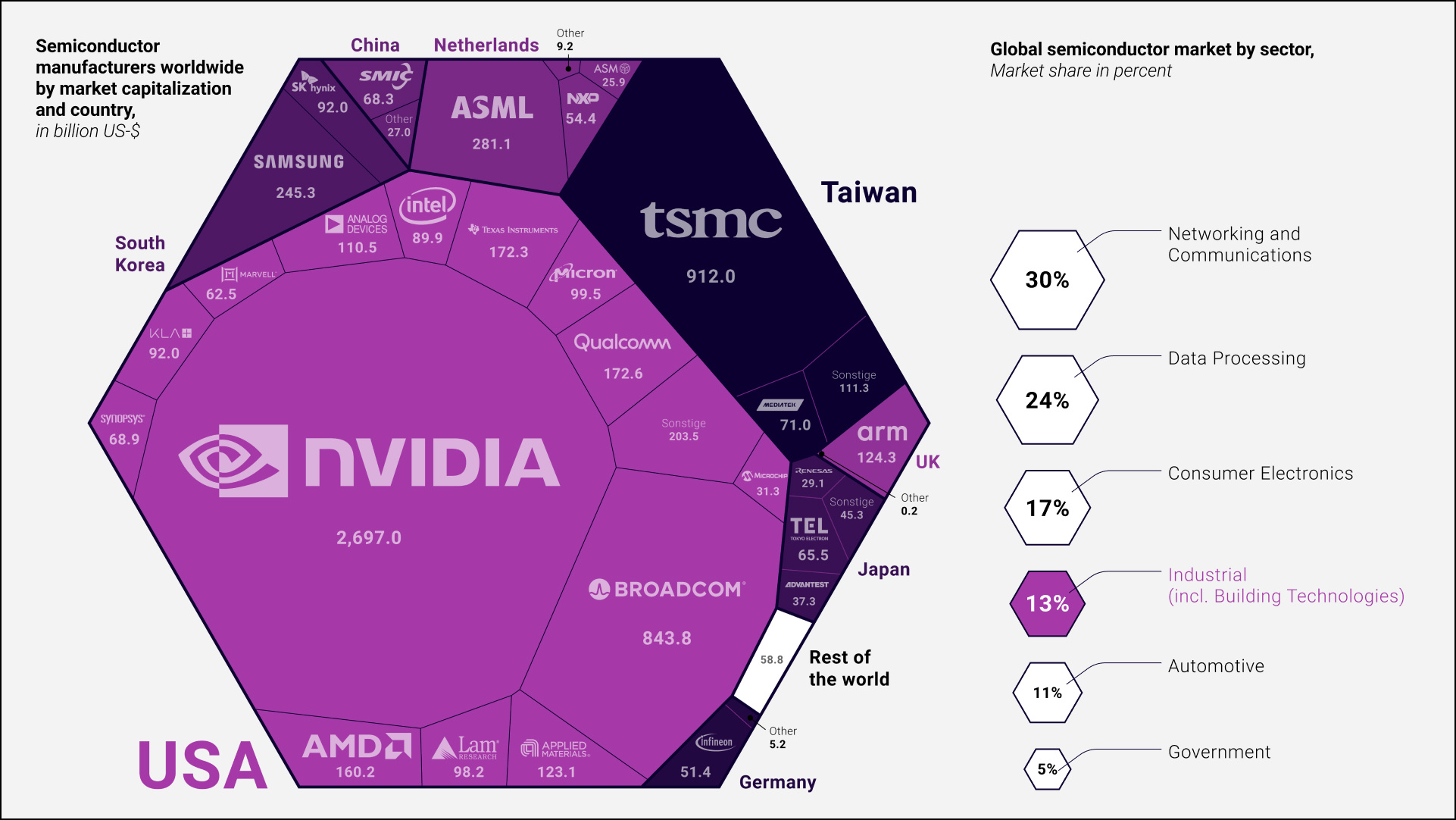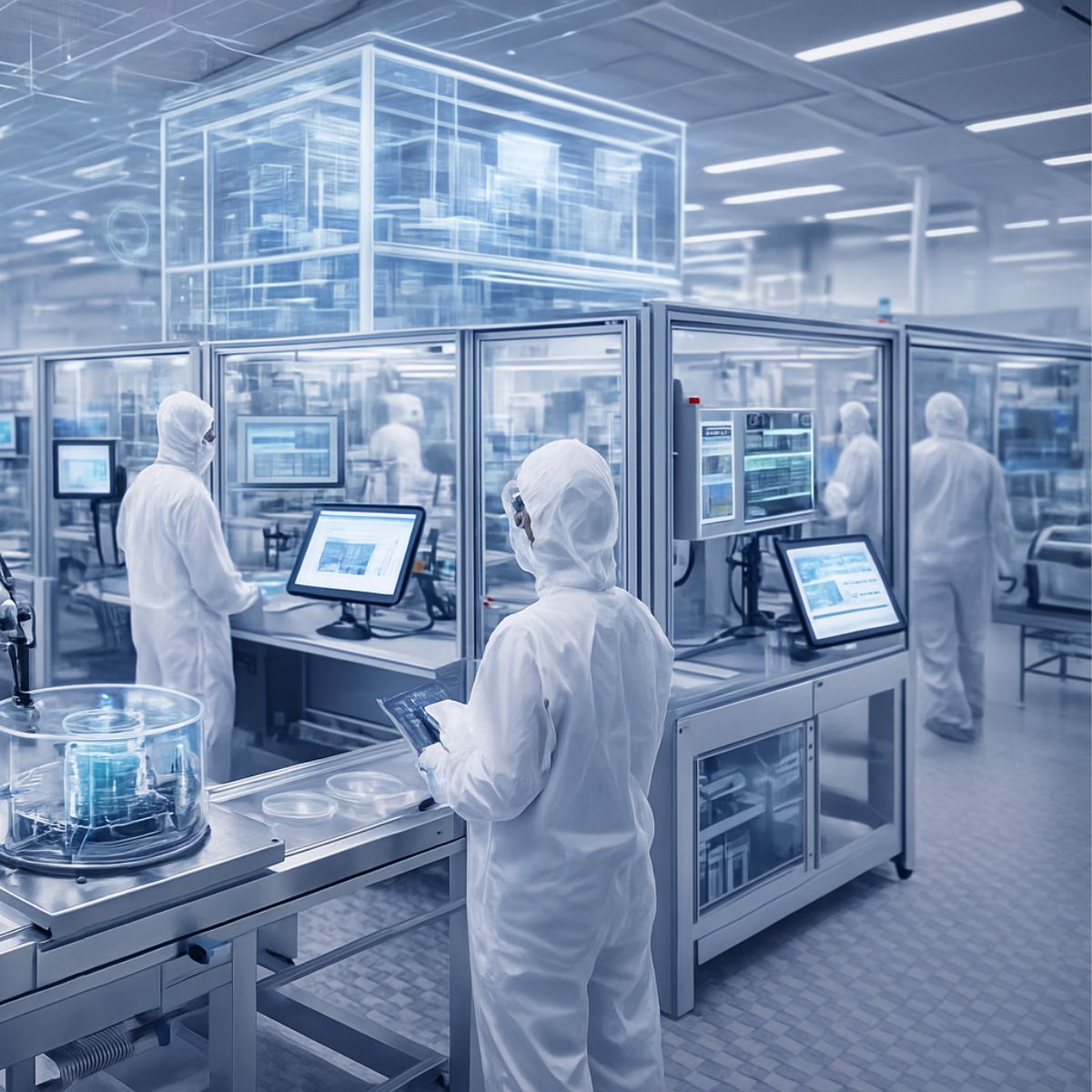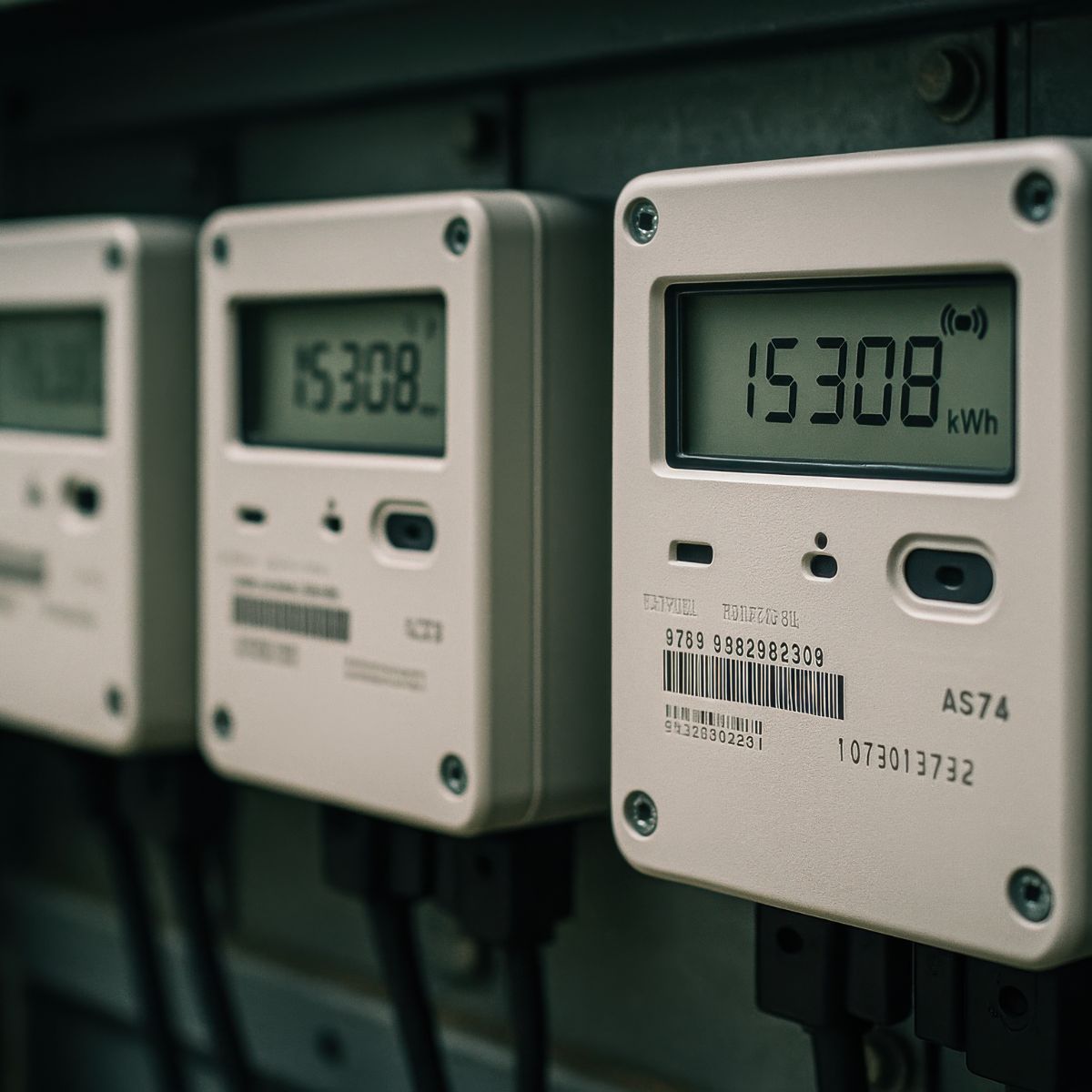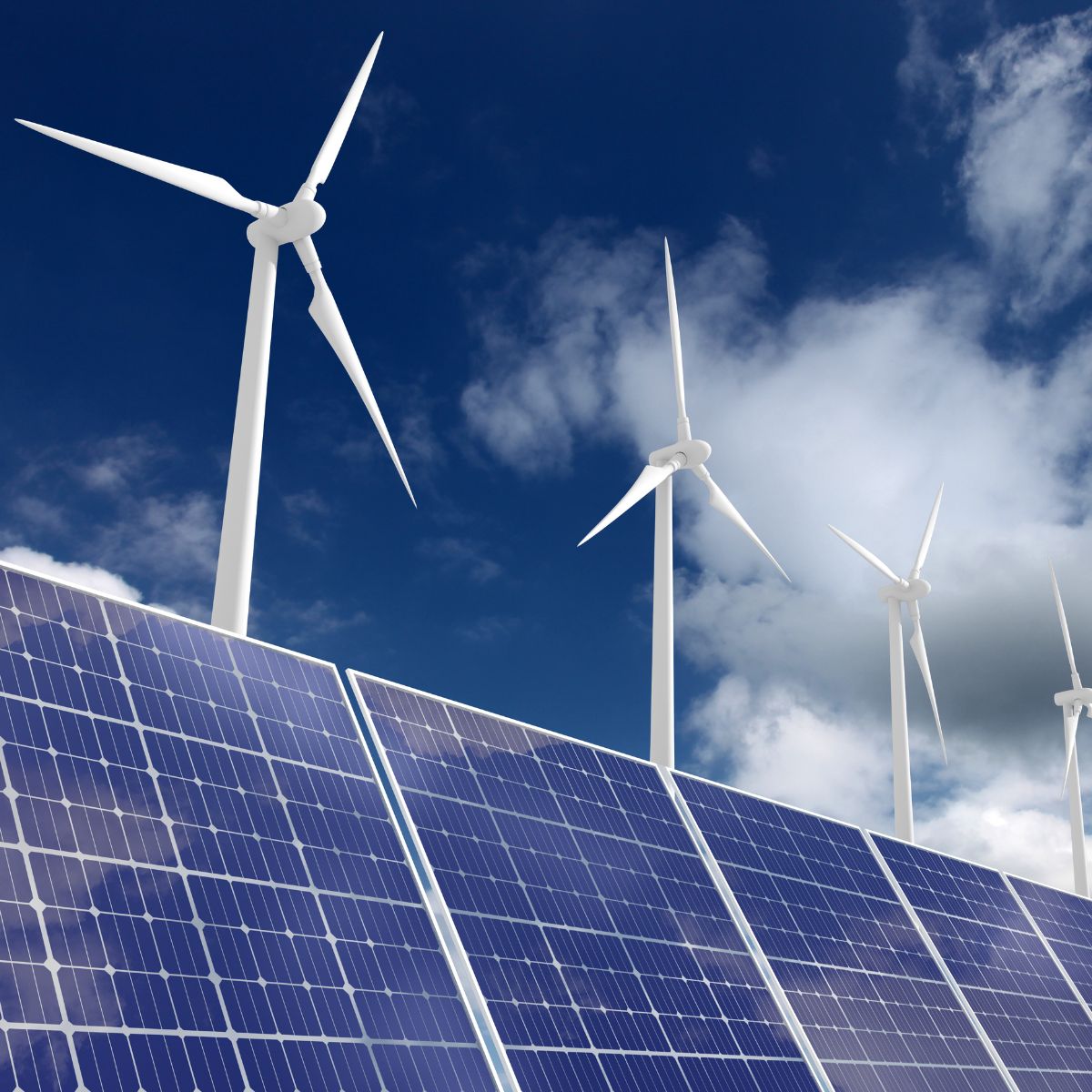Reading time: 10 minutes
Semiconductors in Smart Building Technology
Over the next ten years, digitalization in the building sector will save billions in energy and operating costs, but only for those who strategically implement semiconductor technologies. With rising energy prices, stricter climate regulations, and increasing competitive pressure, the building sector is at a decisive turning point: those who fail to optimize the energy efficiency, automation, and security of their buildings will not only lose competitiveness but also risk compliance issues and rising operating costs.
These inconspicuous semiconductors, tiny electronic components found in sensors, control systems, and networks, are the crucial success factor. They form the technological foundation for smart buildings, enabling the transformation of rigid, energy-intensive buildings into flexible, efficient, and sustainable properties. However, the current semiconductor shortage and geopolitical tensions jeopardize this development. Those who fail to understand these interrelationships and plan accordingly risk falling behind.
This analysis highlights not only the technical fundamentals but, more importantly, the economic significance and strategic implications of semiconductors for the building industry, and how decision-makers can set the right course for the future, starting today.
Key Highlights
- Economic Potential: Semiconductor-based systems can reduce building operating costs by up to 30% and provide the technological foundation for new digital business models in the real estate sector.
- Supply Risk: The global semiconductor supply chain is vulnerable to disruptions, as the 2020-2022 chip shortage demonstrated; strategic procurement planning is becoming a competitive advantage for building projects.
- Technological Change: New semiconductor materials like silicon carbide (SiC) and gallium nitride (GaN), combined with AI and edge computing, are enabling an innovative leap in energy efficiency and building automation.
- Regulatory Pressure: With the EU Energy Performance of Buildings Directive (EPBD) and the Green Deal, smart, energy-efficient building technology is shifting from optional to essential, semiconductors are key to meeting these requirements.
- Strategic Dependencies: Europe imports over 60% of its semiconductors from Asia; the European Chips Act, with investments of €43 billion, aims to improve supply security, but effects are not expected until 2027 onwards.
The economic imperative: Why semiconductors are crucial for building technology
The building sector faces an economic paradigm shift: buildings account for approximately 40% of energy consumption and 36% of CO₂ emissions in the EU. At the same time, energy costs and regulatory requirements are rising. Smart systems and technologies are no longer merely an option but an economic necessity.
The economic benefits are impressive: intelligent sensors and control systems can reduce building energy consumption by up to 30%. For a 10,000 m² office building with annual energy costs of €250,000, this equates to savings of €75,000, every year. Simultaneously, predictive maintenance reduces maintenance costs, and user productivity increases due to optimized room conditions.
The Internet of Things (IoT) networks all building components and enables real-time optimization. Deutsche Telekom aptly describes this as the "nervous system of building automation". But IoT relies on powerful, energy-efficient, and networked semiconductors, from the sensor to the cloud.
This presents a strategic challenge for real estate developers, facility managers, and building operators: investing in intelligent building technology today secures competitive advantages through lower operating costs, higher rental income, and better ESG ratings. Those who hesitate risk facing rising costs and regulatory issues.
Building automation & operating cost optimization
An inefficiently operated building can increase energy costs by up to 30% and negatively impact user comfort and productivity. This is where building automation comes in, with semiconductors as key components.
Economic impact: Large office buildings save between EUR 0.50 and EUR 1.50 per square meter in annual operating costs thanks to intelligent automation. Simultaneously, property values increase: smart buildings achieve an average of 11.8% higher rents and 5-10% higher sales values, as a study by JLL shows.
Technological Basis: Automation relies on three semiconductor pillars:
- Sensor networks capture temperature, air quality, occupancy, and other parameters.
- Control units with microcontrollers process data and execute decisions.
- Communication modules connect all components via KNX, EnOcean, or other standards.
Case study The Edge, Amsterdam: Described as the "smartest building in the world," this Deloitte office building uses over 28,000 sensors for dynamic workspace control, lighting adjustment, and climate control. The result: 70% lower electricity costs compared to conventional buildings and a BREEAM rating of 98.4% (the highest score ever achieved).
This development will continue to gain momentum: According to the KNX Association, the market for building automation is growing by 10-12% annually, driven by economic benefits and regulatory requirements such as the European Energy Performance of Buildings Directive (EPBD).
Energy Management and Sustainability: From Cost Factor to Competitive Advantage
Rising energy costs and ambitious climate targets make intelligent energy management not just an ecological imperative, but primarily an economic one.
Economic impact: McKinsey estimates that intelligent building technology can reduce CO₂ emissions by up to 15%, with a payback period of just 2-3 years. With the introduction of CO₂ pricing (currently €55/tonne in Germany, rising to potentially €100/tonne, especially with the introduction of the European emissions trading system for fuels from 2027), this becomes a direct cost factor.
Key Applications in Practice:
LED lighting has revolutionized lighting technology: Modern LED systems consume 80% less electricity than conventional lighting and have a three to five times longer lifespan. For office spaces with a typical lighting power density of 12-25 W/m², this results in considerable savings. LED semiconductors and intelligent lighting controls (presence detection, daylight harvesting) can save approximately €35,000-€50,000 annually in electricity costs for a typical 10,000 m² office building.
Photovoltaics and energy storage: Increasingly, buildings are transforming from energy consumers into energy producers (prosumers). The semiconductors within PV cells and inverters are central to this transformation. The economic appeal is considerable:
- Self-consumed solar power costs approximately 7-12 Euro cents/kWh, compared to 25-40 Euro cents/kWh for grid electricity (as of April 2025)
- Battery storage systems increase the self-consumption rate from 30% up to 70%
- Payback periods range from 6-10 years, with a system lifespan exceeding 25 years
Case study Freiburg town hall in Stühlinger: This PlusEnergy administration building generates more energy than it consumes, thanks to its PV-integrated façade and roof. Its intelligent energy management system, based on numerous semiconductor sensors and control units, continuously optimizes all energy flows. The result: energy costs were reduced by 85%, with only a 10% increase in construction costs.
New semiconductor materials as game changers: The VDE (Association for Electrical, Electronic & Information Technologies) emphasizes: "The energy transition cannot take place without microelectronics." In particular, power semiconductors made of silicon carbide (SiC) and gallium nitride (GaN) enable more compact and efficient power converters, improving efficiency across all areas, from PV systems to e-mobility.
Security and Asset Protection: Minimizing Risk Through Intelligent Systems
Security breaches or system failures can pose an existential threat to building operators. Modern security systems offer significant added value in this regard.
Economic impact: According to insurance data, modern building security technology can reduce break-ins by up to 70% and decrease the extent of damage in fires by 30-50%. This leads to lower insurance premiums (typically 10-20% discount) and reduces potential business interruptions.
Innovation through specialized semiconductors:
Access Control: Modern biometric systems combine camera sensors with AI processors for reliable identification. "Anti-spoofing" technologies distinguish between real individuals and attempts to deceive (e.g., photos, masks), enabled by specialized image sensors and on-chip AI processing.
Case Study: Allianz Arena Munich: The stadium implemented an integrated security system featuring biometric access points, AI-supported video surveillance, and networked fire alarm systems. The investment paid for itself within three years due to reduced security personnel costs (20% fewer staff required), lower insurance premiums, and enhanced visitor safety.
Video Surveillance with AI: The latest generation of surveillance cameras can independently interpret situations and trigger alarms thanks to embedded AI chips. Furthermore, video surveillance cameras equipped with AI processors can not only recognize objects but also perform complex analyses such as people counting, movement pattern analysis, and automatic tracking.
The economic benefits go far beyond theft prevention:
- Automated access systems reduce personnel costs by 40-60%.
- AI-supported video analytics enable crowd management and optimization of visitor flow.
- Preventive fire protection using multi-criteria sensors lowers insurance premiums.
AI and Edge Computing: The Next Level of Building Intelligence
What was once a "nice-to-have" is becoming a competitive advantage: Artificial intelligence, implemented directly within building sensors and control systems, enables autonomous optimization and new functionalities.
Economic impact: According to a BCG study, AI-optimized buildings can achieve additional energy cost savings of 10-15% and reduce maintenance costs by up to 25% through predictive maintenance.
Enabling Technology: Edge AI processors from NVIDIA, Intel, and startups bring AI computing power directly into sensors and control units. This enables:
- Real-time decisions without cloud latency
- Continuous learning and adaptation to user behavior
- Privacy-compliant analyses, as sensitive data remains within the building
Case Study: Hammerbrooklyn DigitalCampus Hamburg: This smart office building utilizes Edge AI systems for predictive energy optimization. The AI continuously analyzes historical data, weather forecasts, and building usage patterns to dynamically adjust HVAC systems. The result: 22% lower energy consumption compared to conventional control strategies.
This development is driven by the availability of specialized AI chips capable of running complex neural networks with minimal power consumption, ideal for building applications where energy-efficient, low-maintenance solutions are essential.
Electromobility and Charging Infrastructure: New Business Models Through Semiconductor Innovation
The electrification of transport creates new interfaces between buildings and mobility, offering considerable economic potential for property owners.
Economic impact: Charging infrastructure is increasingly becoming a competitive advantage for real estate. Buildings with integrated EV charging points are more attractive to tenants and investors, especially for commercial properties. According to an analysis by CBRE, demand for office properties with charging infrastructure is increasing significantly, particularly among larger companies, over 40% of which are actively seeking such solutions. Simultaneously, new revenue models are emerging for building operators through billing and charging services.
Semiconductors as Enablers:
Wide-Bandgap Technology: SiC and GaN semiconductors enable the development of more compact and efficient power electronic systems. Their use leads to improved efficiency and enables smaller system sizes, which can significantly reduce installation and operating costs.
Load Management via Intelligent Chips: Integrating multiple charging points into a building requires intelligent load management to prevent grid overloads and costly peak demand charges. Systems like the CP6000 series from ChargePoint allow for dynamic distribution of charging power across up to 100 charging points, ideal for commercial buildings with limited grid capacity. The control system relies on powerful semiconductors that regulate loads in real-time, thereby reducing operating costs.
Case Study: V2G Project Utrecht: In an office complex in Utrecht, 250 bidirectional charging stations were installed that supply electricity to EVs during the day and can feed electricity back into the building in the evening. The investment paid for itself in just four years through:
- A 40% reduction in grid connection costs.
- A 25% reduction in electricity costs through peak load shaving.
- Optimization of the PV system's self-consumption rate from 35% to 75%.
Bidirectional charging, enabled by special semiconductor-based inverters, transforms electric vehicles from mere consumers into flexible energy storage units for buildings, a groundbreaking development enabling entirely new energy concepts.
Security of Supply and Supply Chains: Strategic Challenges for the Construction Industry
Semiconductor supply is becoming a strategic risk factor for construction projects and building operators. The recent chip shortage has highlighted the construction industry's dependence on functioning supply chains.
Economic Impact: The 2020-2022 semiconductor crisis led to significant delays and cost increases. Specific consequences for construction projects included:
- Delivery delays of up to 12 months for critical control systems.
- Price increases of 10-40% for electronic components.
- Project postponements due to unavailable components.
German industry is particularly vulnerable: according to a Deloitte study (Link likely German), it sources 62% of its semiconductors from just five Asian countries, primarily Taiwan (23%). This import dependence, coupled with rising geopolitical tensions, creates considerable risks.

Strategic Countermeasures: The European Chips Act, a €43 billion program to bolster the European semiconductor industry, aims to increase Europe's global market share to 20% by 2030. Specific projects, such as the construction of an Intel factory in Magdeburg (investment: €30 billion), are intended to strengthen European supply chains, however, impact is not expected until 2027 at the earliest.
Action Areas for Construction Stakeholders:
- Early Component Planning: Leading construction companies have begun specifying critical electronic components during the planning phase and procuring them early.
- Diversified Supply Chains: Instead of relying on a single supplier, successful projects utilize multiple suppliers and explore technology alternatives.
- Strategic Partnerships: Long-term contracts with technology providers secure availability and stabilize prices, an advantage larger construction companies leverage to gain a competitive edge.
Case Study: Vonovia's Digitalization Offensive: The leading housing corporation has concluded a five-year framework agreement with Siemens for the supply of smart building components. This long-term agreement enabled Vonovia to continuously implement its digitalization strategy despite the chip crisis, while competitors had to postpone projects.
Outlook and Strategic Implications for Decision-Makers
- Rethink Investment Planning: Intelligent building technology should no longer be viewed merely as a cost factor, but as a strategic investment. The Total Cost of Ownership (TCO) over the entire life cycle is crucial, not just the initial acquisition costs.
- Foster Expertise Development: The shortage of skilled professionals in the smart building sector is intensifying. Successful companies are increasingly investing in digital competencies and forging partnerships with technology providers.
- Secure Data Sovereignty: Whoever controls building data will control future business models. A well-defined data and API strategy will become a competitive advantage.
- Sustainability as a Value Driver: ESG (Environmental, Social, Governance) requirements are becoming tangible economic factors. Semiconductor-based building technology is crucial for achieving sustainability targets and improving related ESG ratings.
Digital Building Technology: Key Questions for Practice
What ROI can semiconductor-based building technology generate?
The payback period is typically between 3 and 7 years, depending on the specific application.
- Energy management systems often achieve payback after just 2 to 4 years.
- Complex building automation systems typically require 5 to 7 years for payback.
- Rising energy prices and regulatory requirements further strengthen the business case.
- Smart buildings demonstrably increase their market value by 5 to 10 percent.
How can construction projects be safeguarded against supply bottlenecks for electronic components?
Successful strategies include:
- Early specification and ordering of critical components, ideally with fixed pricing.
- Flexibility in specifications to allow switching to alternative products.
- Collaboration with system integrators who maintain inventory or have secured supply chains.
- Considering delivery times and availability as selection criteria alongside price and performance.
Which semiconductor innovations will have the greatest economic impact on buildings in the next 3-5 years?
Three technological developments will be particularly relevant:
- Edge AI processors enable self-learning, autonomous building control systems.
- Wide-bandgap power semiconductors (SiC/GaN) enhance the energy efficiency of power supplies and e-mobility applications.
- Integrated sensor fusion chips combine multiple sensor functions in a single device, simplifying installation and maintenance.
All three technologies reduce operating costs while simultaneously enhancing building functionality.
How is 5G technology changing the building industry, and what role do semiconductors play?
5G enables the networking of thousands of devices with minimal latency. This particularly benefits three application areas:
- Wireless, battery-operated sensor networks, deployable even in existing buildings.
- Augmented Reality (AR) for maintenance and facility management, optimizing maintenance processes.
- Autonomous systems such as cleaning robots or security drones that can be controlled in real time
5G technology relies on highly integrated semiconductors for signal processing, antenna control, and edge computing.
What cybersecurity risks arise from increased semiconductor use and connectivity in buildings?
As connectivity increases, the attack surface expands considerably. The three biggest risks are:
- Unauthorized access to building systems via unsecured IoT devices.
- Manipulation of critical functions such as access control or the energy supply.
- Theft of sensitive data regarding building usage and operations.
As countermeasures, leading providers rely on Hardware Security Modules (HSMs) or Secure Elements (SEs) and end-to-end encryption.
Conclusion: Semiconductors as a Strategic Success Factor for the Building Sector
The transformation of the building sector is irreversible: investing in intelligent, semiconductor-based building technology today secures economic and strategic advantages. This technology not only enables cost optimization through energy savings and more efficient processes but also facilitates higher property values, new business models, and robust compliance with increasingly stringent regulations.
However, the semiconductor shortage and associated supply chain risks underscore that strategic planning and long-term partnerships with technology providers are becoming critical for success. Those who successfully navigate these challenges will be optimally positioned for the future of the building industry.
Therefore, for decision-makers in the construction and real estate industry, it is essential to view semiconductor technology not merely as a technical detail but as a strategic success factor, one that determines the competitiveness and future viability of buildings and business models.










